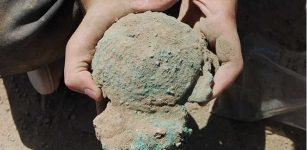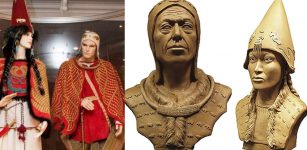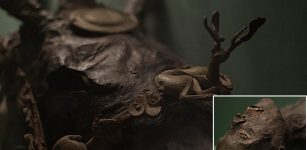Who Was Pseudo-Nero?
Conny Waters - AncientPages.com - Nero (37-68 A.D) was one of ancient Rome’s famous, or rather infamous emperors. Nero was a tyrant, and he is today best known for his debaucheries, killing his mother, committing several political murders, and persecuting Christians. He also had a passion for music that probably led to an apocryphal rumor that he “fiddled” while Rome burned during the great fire of 64 A.D.
Credit: Public Domain
In June 68 A.D, Emperor Nero committed suicide near the villa of his freedman Phaon, and it did not take long before various Nero impostors appeared between the autumn of 69 AD and the reign of the emperor Domitian, the third and last emperor of the Flavian dynasty.
The first pseudo-Nero appeared in the Roman province of Achaia, which is today in modern Greece. It is unknown why he chose this specific place. Still, it could be because Nero had recently visited Greece (66-67 AD) to participate in its Panhellenic Games.
After the emperor Nero committed suicide near the villa of his freedman Phaon in June of 68 AD, various Nero impostors appeared between the autumn of 69 AD and the reign of the emperor Domitian.
According to historians, there were three pseudo-Neros. These historical imposters were most likely inspired by circulating prophecies that predicted Nero would regain his kingdom in the East.
The Torches of Nero, by Henryk Siemiradzki. According to Tacitus, Nero targeted Christians as those responsible for the fire.
The first Pseudo-Nero appeared in the autumn of 68 AD, or the early winter of 69 AD, in the Roman province of Achaia, modern Greece. Nero had recently visited Greece (66-67 AD) to participate in its Panhellenic Games, which may account for some of the impostor's support.
According to the historian Tacitus, the fake Nero, who was either a slave from Pontus or a freedman from Italy, made appeals to bring Roman soldiers en route to Italy over to his growing armed force.
Tacitus does not reveal much about the impostor's early career, except that the Pseudo-Nero gathered around him a group of army deserters and then set out to sea, where he began a career in piracy while maintaining his claim to be the emperor. He was eventually apprehended and beheaded.
The second pseudo-Nero was a Roman man named Terentius Maximus.
He gained his first followers in Asia and many more during his march to the Euphrates. When things did not turn out as he hoped, he fled to Parthia and tried to gain their support.
In time, his true identity was revealed, and he was executed.
Twenty years after Emperor Nero’s death, the third pseudo-Nero appeared during the reign of Domitian. Parthians supported him, but he, too, had to give up the idea of pretending to be the genuine Emperor Nero.
Updated on November 15, 2023
Written by - Conny Waters AncientPages.com Staff
Expand for referencesGallivan, P.A. "The False Neros: A Re-Examination," Historia 22 (1973)
More From Ancient Pages
-
 Tangaroa – Polynesian God Of Ocean And Fish In Constant Struggle With His Brother
Myths & Legends | Jun 2, 2020
Tangaroa – Polynesian God Of Ocean And Fish In Constant Struggle With His Brother
Myths & Legends | Jun 2, 2020 -
 World’s Oldest Moon Map Carved Into Ireland’s 5,000 Year-Old Tomb At Knowth
Featured Stories | Jun 25, 2014
World’s Oldest Moon Map Carved Into Ireland’s 5,000 Year-Old Tomb At Knowth
Featured Stories | Jun 25, 2014 -
 Rare Discovery Of 4,300-Year-Old Copper Ingots Left By Mistake In A Settlement In Oman
Archaeology | Jun 2, 2023
Rare Discovery Of 4,300-Year-Old Copper Ingots Left By Mistake In A Settlement In Oman
Archaeology | Jun 2, 2023 -
 Ruins Of Xunantunich – Mayan City That Once Flourished
Civilizations | Jan 12, 2022
Ruins Of Xunantunich – Mayan City That Once Flourished
Civilizations | Jan 12, 2022 -
 Puzzling Jewellery From Grave Of High Status Viking Woman Delivered At Museum’s Door
Artifacts | Jul 23, 2022
Puzzling Jewellery From Grave Of High Status Viking Woman Delivered At Museum’s Door
Artifacts | Jul 23, 2022 -
 Ancient Egyptian Toys And Games In Focus
Featured Stories | Jan 15, 2016
Ancient Egyptian Toys And Games In Focus
Featured Stories | Jan 15, 2016 -
 New Attempt To Solve The Easter Island Mystery – What Did Rapa Nui Look Like Before Europeans Arrived?
Archaeology | Sep 20, 2017
New Attempt To Solve The Easter Island Mystery – What Did Rapa Nui Look Like Before Europeans Arrived?
Archaeology | Sep 20, 2017 -
 Vahanas – Sacred Animal Vehicles Of Hindu Gods And Goddesses
Featured Stories | Apr 30, 2017
Vahanas – Sacred Animal Vehicles Of Hindu Gods And Goddesses
Featured Stories | Apr 30, 2017 -
 Stunning Facial Reconstruction Of ‘Siberian Tutankhamun’ And His ‘Queen’ Who Died 2,600 Years Ago
Archaeology | Jan 12, 2021
Stunning Facial Reconstruction Of ‘Siberian Tutankhamun’ And His ‘Queen’ Who Died 2,600 Years Ago
Archaeology | Jan 12, 2021 -
 Ancient Brewing And Natufian Rituals – What Came First, Beer Or Bread?
Archaeology | Sep 14, 2018
Ancient Brewing And Natufian Rituals – What Came First, Beer Or Bread?
Archaeology | Sep 14, 2018 -
 Earliest And Largest Scythian Princely Tomb Discovered In Siberia By Swiss Archaeologist
Archaeology | Jan 16, 2018
Earliest And Largest Scythian Princely Tomb Discovered In Siberia By Swiss Archaeologist
Archaeology | Jan 16, 2018 -
 Rare Bes Mugs Reveal Ancient Egyptians Drank Hallucinogenic Cocktails During Rituals
Archaeology | Nov 18, 2024
Rare Bes Mugs Reveal Ancient Egyptians Drank Hallucinogenic Cocktails During Rituals
Archaeology | Nov 18, 2024 -
 Oldest Known Human-Made Nanostructures Found In Ancient Artifacts In Tamil Nadu
Ancient Technology | Nov 23, 2020
Oldest Known Human-Made Nanostructures Found In Ancient Artifacts In Tamil Nadu
Ancient Technology | Nov 23, 2020 -
 Secrets Of Mysterious Bronze Age Hoard Found In Rosemarkie, Scotland Revealed
Archaeology | Jul 31, 2024
Secrets Of Mysterious Bronze Age Hoard Found In Rosemarkie, Scotland Revealed
Archaeology | Jul 31, 2024 -
 Machu Picchu Is Older Than Previously Thought – New Study Reveals
Archaeology | Aug 4, 2021
Machu Picchu Is Older Than Previously Thought – New Study Reveals
Archaeology | Aug 4, 2021 -
 Sacrificial Remains From The Iron Age Unearthed Near Aarhus, Denmark
Archaeology | Oct 14, 2015
Sacrificial Remains From The Iron Age Unearthed Near Aarhus, Denmark
Archaeology | Oct 14, 2015 -
 LIDAR Discovers 18-Kilometer (11-Mile) Maya Road In The Yucatan Jungle
Archaeology | Dec 5, 2023
LIDAR Discovers 18-Kilometer (11-Mile) Maya Road In The Yucatan Jungle
Archaeology | Dec 5, 2023 -
 Evidence Of Rare Roman-Celtic Temple Near Lancaster Castle
Archaeology | Mar 9, 2023
Evidence Of Rare Roman-Celtic Temple Near Lancaster Castle
Archaeology | Mar 9, 2023 -
 First Early Roman Fortlet Found On The Isle of Anglesey, North Wales
Archaeology | Nov 26, 2015
First Early Roman Fortlet Found On The Isle of Anglesey, North Wales
Archaeology | Nov 26, 2015 -
 Long-Lost Mesopotamian Queen Hama Discovered By Student Just By Reading Books
Archaeology | Feb 14, 2019
Long-Lost Mesopotamian Queen Hama Discovered By Student Just By Reading Books
Archaeology | Feb 14, 2019


